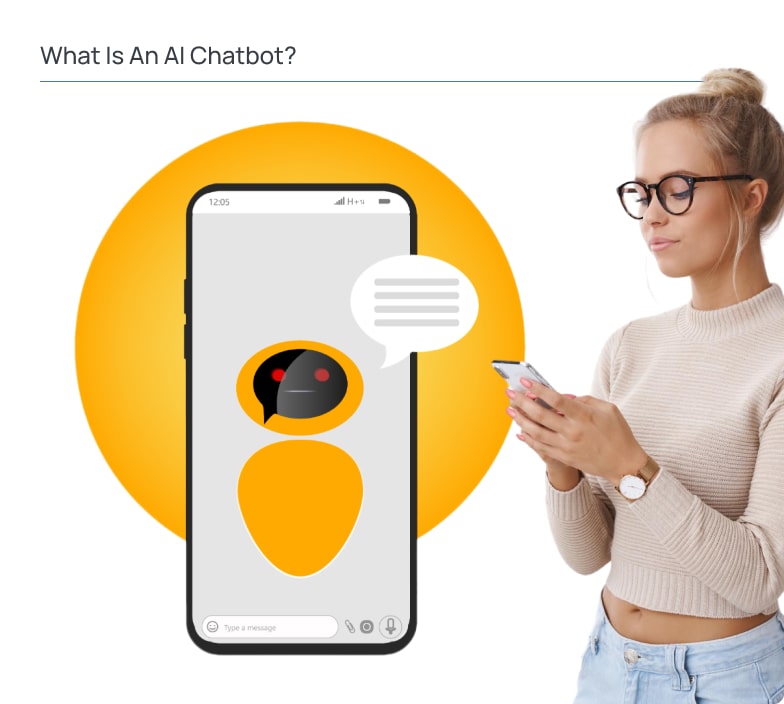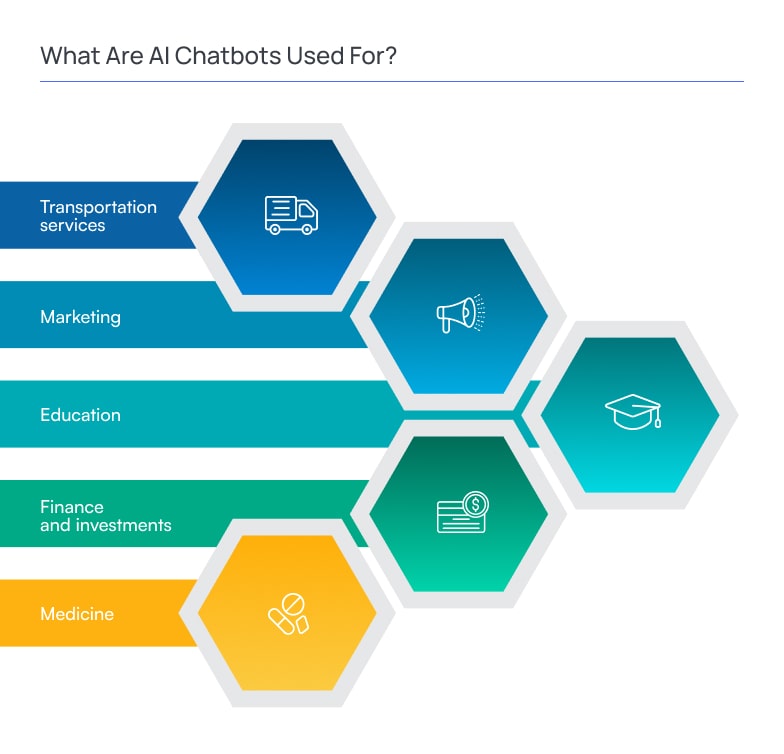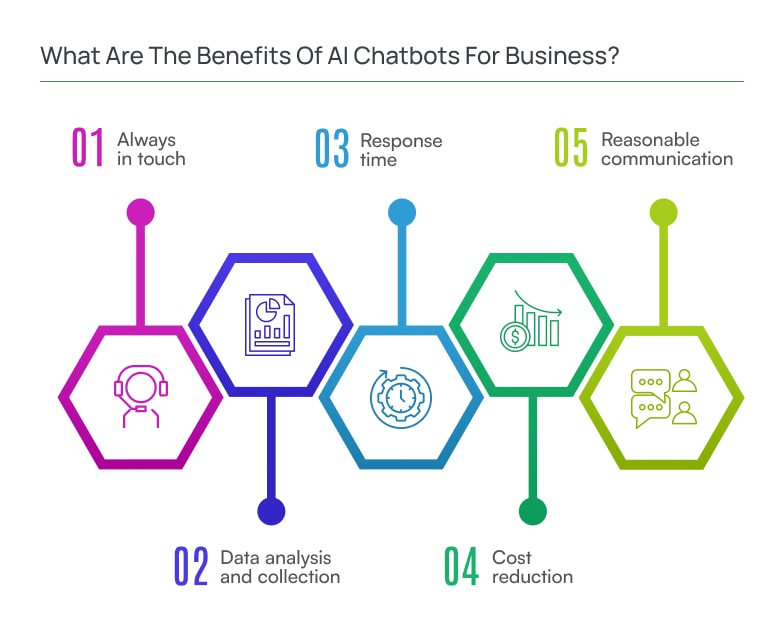The media has discussed artificial intelligence and its capabilities for the last few years. Although there are already many bots with artificial intelligence functioning today, the most important breakthrough in this industry was the famous ChatGPT. Chatting with people, providing recommendations, creating pictures and videos, writing scenarios, and much more have become possible thanks to the introduction of AI.
The important thing is that even a person with no background in development can create artificial intelligence software thanks to the development of tools for building an AI chatbot without using code. We have created a complete step-by-step guide that will answer the main question of thousands of people – «how to build an AI chatbot»?
What Is an AI Chatbot?
Chatbots are a family of programs that use human speech recognition in spoken and written form to perform various tasks or interact with the user. Chatbots help to solve issues in customer communication and optimize the working system within a company. The employees of the company will have time for more important and complex tasks that they have been sacrificing to solve mandatory routine problems.
Modern chatbots, such as ChatGPT, are based on large language models (LLM) – they are not just the new entertainment of today. The impact of chatbots on business is growing rapidly. The technology is increasingly being used to improve employee productivity and efficiency. Given their capabilities, such tools can completely replace some positions, particularly in areas such as coding, content creation, and customer service.

What are AI Chatbots Used for?
Artificial intelligence has wide usage in various spheres, including medicine, finance, industrial automation, transportation, education, the gaming industry, and many others. It is used to automate routine tasks, optimize business processes, analyze big data, recognize patterns, manage systems, and create smart assistants. Here’s how artificial intelligence is helping to tackle major challenges in various fields:
- Transportation services. Logistics is one of the most popular areas of usage of bots equipped with AI. Such programs help to find and build the most optimal ways to transport all kinds of cargo.
- Marketing. Marketing specialists are very happy that the trend of artificial intelligence has started to boom. It helps to solve a number of tasks in marketing: building advertising campaigns, analyzing the target audience, analyzing competitors, and much more.
- Education. Sometimes, artificial intelligence can know even more than teachers in schools and universities. If you use it correctly, such chatbots can help you learn faster and more efficiently.
- Medicine. It is hard to believe, but AI is already working in medicine. For example, British university graduates have announced that they are creating new genetic sequences to treat complex diseases with the help of AI.
- Finance and investments. An AI chatbot can easily assist in multiplying your money on the stock exchanges. Intelligent software can tell you which assets are the safest to invest in.
With each passing year, artificial intelligence is finding its uses in new areas and helping millions of people solve difficult issues faster and more easily.

What are the Benefits of AI Chatbots for Business?

Chatbots have become an important part of quality customer service in a wide range of businesses. Businesses use chatbots to automate ordering, payment, dispute resolution, and even technical support services for customers. The most important benefit of such bots is that they are available 24 hours a day and have no days off. And what about chatbots with artificial intelligence? How does artificial intelligence affect business? Chatbot technologies are becoming an integral part of communication between customers and businesses. Now, 58% of companies in the B2B sector and 42% in the B2C sector use chatbots in their daily work. AI plays an important role in building chatbots. Generally, chatbots with artificial intelligence have many benefits for businesses, but we decided to highlight only the most important ones:
- Always in touch. There are often occasions when customers really want to place an order at night or utilize other services. Chatbots have no weekends and no rest and will serve your business’ customers at any time of the day or night.
- Response time. Obviously, bots respond very quickly. Even the best operator can’t give an answer to a customer faster than a bot can. Statistics show that 90% of customers are annoyed by the long wait for a response, and this may even contribute to the fact that the customer will turn to your competitors.
- Reasonable communication. A chatbot can imitate operator interaction, and it can be taught to understand and communicate in emojis and gifs, identify regional slang, and communicate accordingly.
- Data analysis and collection. An artificial intelligence chatbot can help businesses collect, analyze, and store the necessary information about a customer or lead. It can also analyze customer data to provide instant expert advice.
- Cost reduction. A bot requires regular maintenance, but it does not ask for a salary every month. By analyzing the difference between a bot and a regular operator, it can be emphasized that the first option will cost much less.
Do you want to build your own AI software?
Contact usWhat Toolkit Do You Need to Create an AI Chatbot?
What tools or technology stack is needed to create a chatbot from scratch? This question concerns many entrepreneurs who have decided to develop a chatbot with artificial intelligence on their own.
- NLP system. This is software that allows a robot to detect human speech and respond to queries. With the help of NLP, it is possible to make your bot multilingual.
- Chatbot placement. The benefit of chatbots is that popular social networks and other resources allow you to embed a bot in your system. You need to decide where your bot will be hosted. You can choose between Viber, Telegram, and Facebook or place a «smart assistant» on your website.
- Software for the bot. A bot can’t work independently, so it needs the corresponding software. Tools such as PyTorch, Scikit-learn, Langchain, LLamaIndex, and PineCone.io make AI bots full-fledged assistants with artificial intelligence.
- Servers. Don’t forget to take care of the servers where all the information will be stored. Especially if your business is large or you plan to scale. Popular cloud infrastructure options for chatbots include Google Cloud Resources, AWS, and Microsoft Azure.
The choice of AI chatbot technology stack depends directly on your goals. Therefore, you should first think about the concept of your bot and then think about the technology stack.
8 Steps You Must Take to Make Your Own AI Chatbot

If you want to learn how to make an AI chatbot independently, you must be patient and pay attention to all the details. We have prepared eight steps for you, allowing you to develop chatbot from scratch.
1. Definition of Objectives and Goals
During this first stage, you should define the tasks that your AI chatbot will solve. The most important thing is to set the specific goals of the project. You must clearly define what task you want to automate or what problem you want the AI to solve. As we have already written, artificial intelligence can perform many different tasks, but you need to focus on a few main functions.
2. Data Collection and Analysis
This is, without exaggeration, one of the most responsible steps in the whole pathway. You may ask why. Artificial intelligence chatbot development requires large data volumes. The third step of artificial intelligence chatbot development consists of collecting and preparing the data that will be used to train the system. This may involve collecting data from various sources, cleaning it, transforming it, and preparing it for use in the model.
3. Tech Stack Preparation
To create and develop AI chatbot, a certain technology stack is used. In other words, it is a collection of different technologies and tools. The main tools are specialized software libraries and frameworks, such as TensorFlow and PyTorch, which provide capabilities for developing and teaching neural networks. In addition, statistics, probabilistic models, and machine learning algorithms are used to process and analyze data.
4. Choice of Algorithm and Model
Based on what goals and objectives you have chosen in the second step, the appropriate algorithm and model for solving the problem is determined. The options at this stage can be quite different. For example, it can be a classical machine learning algorithm, a neural network, or a combination of different approaches. The choice depends on the characteristics of the task, available data, and required performance. If your goal is to create a bot that can quickly calculate and apply mathematical formulas, then you should use a machine learning algorithm.
5. Chatbot Education
The education of an artificial intelligence model is based on using big data and machine learning algorithms. These algorithms allow the model to analyze the data, identify patterns in it, and make informed predictions or decisions.
During this stage, the artificial intelligence model is taught on the prepared data. The model analyzes the data, identifies patterns, and is trained based on those patterns. It may include an iterative process during which the model is refined and optimized.
6. Optimization and Testing
After the model is successfully trained, it passes through an optimization and testing phase. The model’s performance, accuracy, and reliability are tested in this phase. The model may be optimized to achieve better results or improve its speed.
It is important here to be as focused as possible and pay enough attention to every detail. If you identify all the drawbacks in advance, the process of creating the software further will happen much faster.
7. Implementation and Utilization
After successful testing and optimization, the model is ready to be implemented and used. You can start the implementation process if no major problems were identified during chatbot testing. The AI chatbot is integrated into an existing system, or a special application is created. It is important to ensure that the model is properly maintained and updated so that it continues to work effectively.
8. Control and Improvement
Even a full-fledged software launch is not the end of creating an AI chatbot. Once the software is implemented, you should monitor it and continuously improve it. Monitoring allows you to track the model’s performance in real-world conditions and identify possible problems or the need to make changes. Based on the findings, adjustments or updates can be made to the model to improve its performance.
Popularize your chatbot among your target audience. Promote it through social media, websites, and other communication channels. Constantly analyze user interactions with the chatbot and make improvements to ensure quality service.
Do you need help with creating a chatbot AI from scratch?
Get in touch with our teamAfterwords
Now, you know how to make an AI bot on your own. Creating artificial intelligence is a complex and multifaceted process that requires deep knowledge of programming, mathematics, and statistics. If you are only a beginner in the IT area, it is recommended that you start by learning the basics of programming and the fundamentals of machine learning. Learning programming languages like Python and frameworks like TensorFlow or PyTorch will help you create and experiment with AI models. It is also important to keep up to date with new AI research and technologies to stay updated with the latest trends and advancements.
The best solution for your business would be to contact experts who are experienced and know how to make a chatbot from scratch. One such company is Binerals. Experienced Binerals specialists apply new approaches and tools to build an AI chatbot with artificial intelligence for any sphere of business.
FAQ
1. How long does it take to build a chatbot from scratch?
You need to decide who will be working on the development to determine the time it takes to create a chatbot from scratch. If you are a beginner and have never done it before, the time to build your own software may take more than one month. A specialized artificial intelligence bot development team will handle this task much faster.Remember that the final results will depend on your project, technical capabilities, and goals. Also, don’t forget to comply with privacy rules and regulations when processing users’ personal data in a chatbot.
2. What might be the challenges in building a chatbot from scratch?
The development of artificial intelligence also raises ethical issues and challenges. Some of them are related to data privacy and the protection of personal information, especially when AI is used in medicine and finance. There are also questions of liability for AI actions, the autonomy of systems, and their interaction with humans.3. Is it safe for a company to share data with a chatbot?
Chatbots train on the large volume of internet data, which helps understand user queries. However, whenever you ask a chatbot to provide a snippet of code or write a simple email for your customer, you may also share important company data. According to the United Kingdom’s National Cyber Security Center (NCSC), chatbots do not automatically add information from requests to their model for others to query.